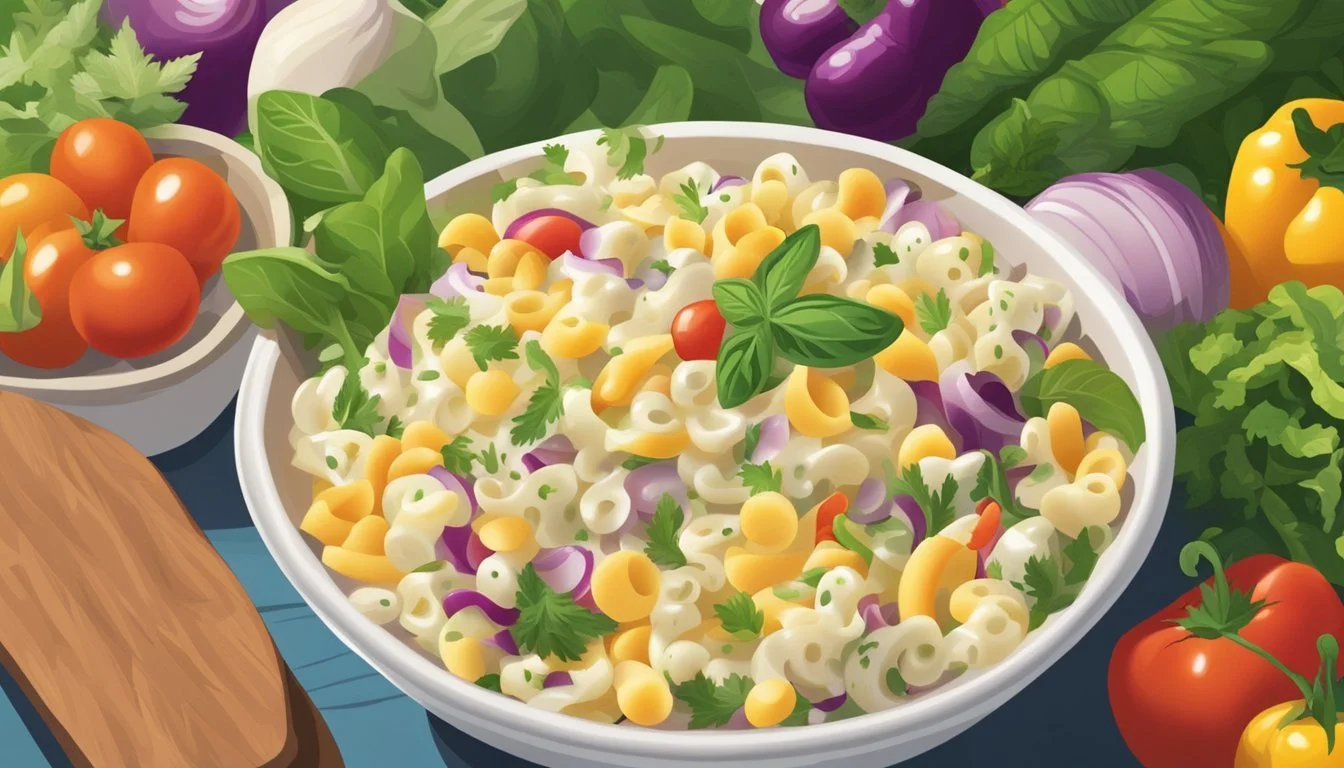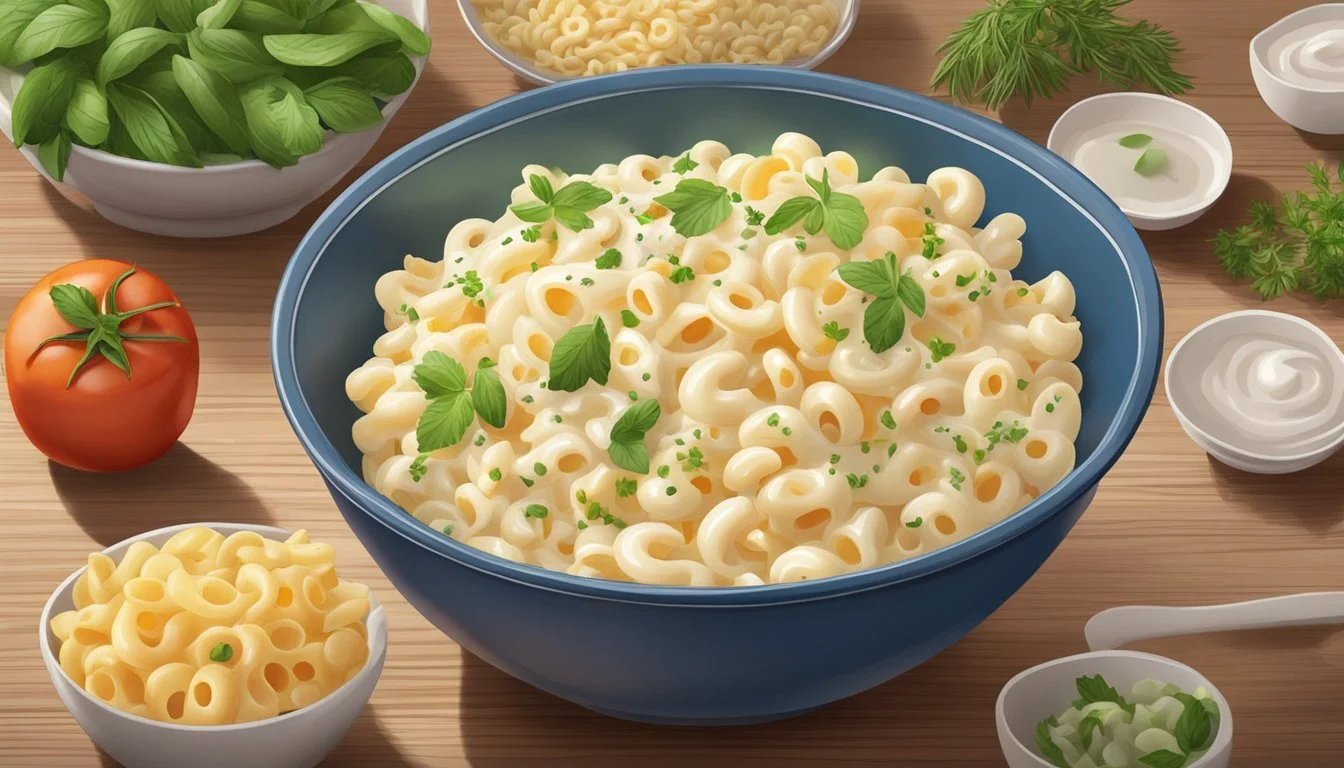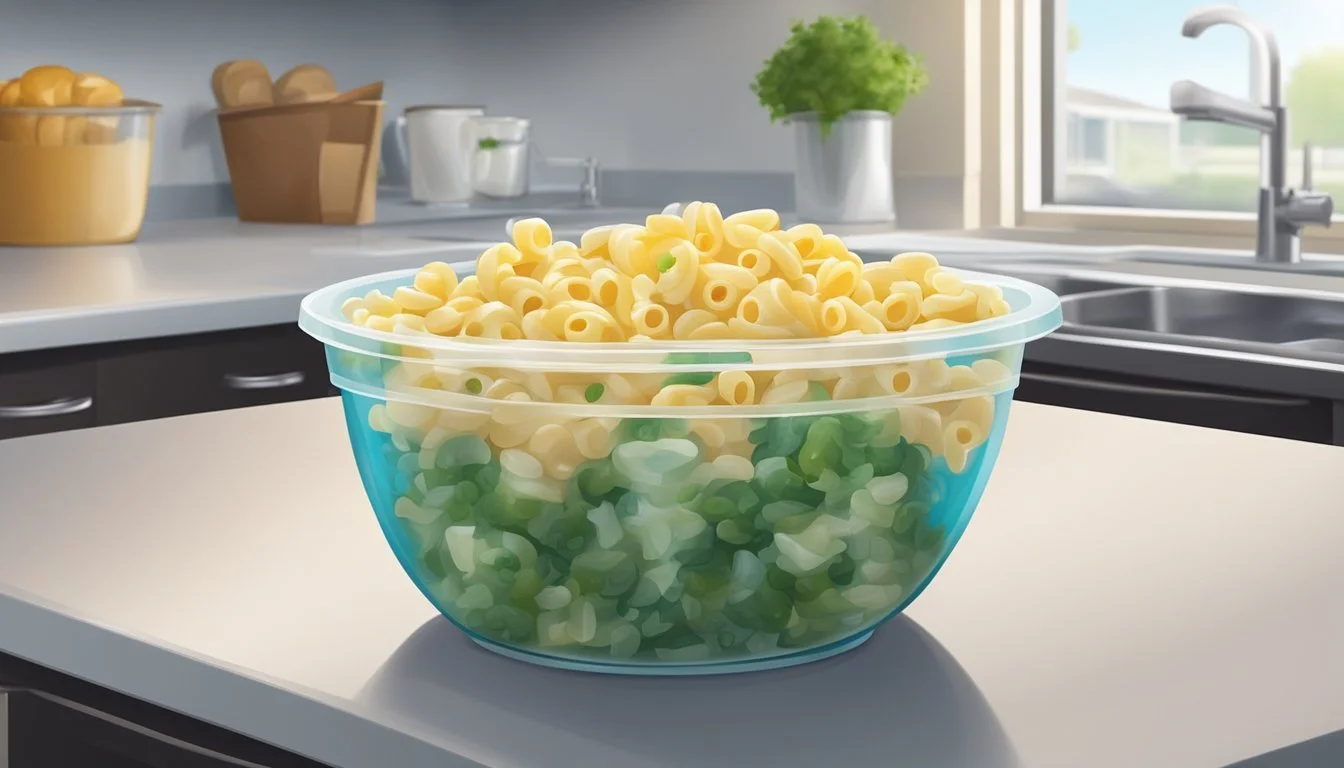Best Way to Reheat Macaroni Salad
Tips for Creamy, Flavorful Results
Macaroni salad, a popular side dish at picnics and potlucks, can be a challenge to keep creamy and flavorful when reheating. Its texture and taste often depend on maintaining the right balance between the pasta (What wine goes well with pasta?) and its dressing. For those looking to revive their dish's original appeal, understanding the best techniques to reheat macaroni salad is essential.
Reheating requires a delicate approach to prevent the pasta from becoming too soft and to ensure that the dressing does not separate or become oily. It's important to maintain the creamy consistency and to ensure the flavors remain well-blended. Proper storage and reheating methods not only restore the dish's appeal but can enhance its flavor, making the macaroni salad as enjoyable as when it was freshly prepared.
Understanding Macaroni Salad Components
The success of macaroni salad hinges on the balance of its components. It's essential to choose the right type of pasta, ensure the dressing is adequate for creaminess, and use proper storage methods to maintain the salad's quality.
The Role of Dressing in Creaminess
Dressing is the key to a creamy macaroni salad. A generous amount of dressing, typically a mixture of mayonnaise and perhaps sour cream, should coat every piece of pasta to prevent dryness. The ingredients in the dressing function as both flavor enhancers and moisture providers, creating a desirable creamy texture.
Essential Creaminess Components:
Mayonnaise: Principal ingredient for velvety texture.
Sour Cream: Adds tanginess and contributes to the creaminess.
Selecting the Right Pasta
Choosing the right pasta affects the overall outcome of the salad. Elbow macaroni is the traditional choice, as its shape holds onto the dressing well and it's the right size for consistency in each bite. The pasta should be cooked just until al dente to ensure it maintains structure without becoming too soft when dressed or reheated.
Pasta Considerations:
Shape: Elbow macaroni’s grooves trap the dressing.
Texture: Cooked to al dente to support the weight of the dressing.
Importance of Proper Storage
How a macaroni salad is stored significantly impacts its freshness and flavor longevity. The salad should be kept in an airtight container inside the refrigerator to prevent exposure to air and contaminants. Proper storage slows down the deterioration process, helping the salad maintain its texture and creaminess over time.
Storage Guidelines:
Airtight Container: Protects from unwanted flavors and drying out.
Refrigeration: Keeps the salad fresh and delays spoilage.
Preparation Before Reheating
A successful reheating process begins with a well-prepared macaroni salad. The key to maintaining creaminess and flavor lies in adjusting the salad's ingredients and ensuring it reaches an optimal temperature before reheating.
Adjusting Salad Ingredients
Before reheating macaroni salad, the cook should examine the consistency of the salad. If the salad appears dry, they may add a small amount of milk or cream to enhance the texture. This addition should be done sparingly, with the cook starting with a tablespoon of liquid for each cup of macaroni salad and stirring thoroughly to distribute the added moisture evenly. The goal is to restore the original creaminess of the salad without making it soggy.
Ensuring Optimal Temperature
The temperature at which macaroni salad is stored before reheating can significantly affect its final quality. Salad leftovers should be brought to room temperature for about 15 to 20 minutes before warming up to avoid temperature shock, which could impact texture. Additionally, this step ensures that the salad heats evenly, preventing cold spots. The cook should remember to stir the salad gently once more before applying heat to promote even heating and maintain the integrity of the pasta.
Methods to Reheat Macaroni Salad
Reheating macaroni salad while maintaining its creaminess and flavor mainly involves controlling the temperature and adding moisture when necessary. The right reheating technique can make a significant difference in the texture and taste of the salad.
Stovetop Reheating Technique
On the stovetop, one can gently reheat macaroni salad over low heat. They should transfer the salad to a saucepan and add a small amount of milk or cream to keep it creamy. Stirring constantly is crucial to prevent it from sticking to the bottom of the pan or becoming too hot, which could alter the flavor and texture.
Microwave Reheating Method
To reheat in the microwave, they should place the macaroni salad in a microwave-safe bowl and cover it with a damp paper towel to retain moisture. They should use a microwave-safe lid if available, which will also help to maintain the desired creaminess. They must heat it in 30-second intervals, stirring in between to ensure even reheating without overheating.
Oven Reheating Approach
When using an oven to reheat macaroni salad, one must first preheat the oven to a moderate temperature, around 350 degrees Fahrenheit. They should spread the salad in an even layer in an oven-safe dish and lightly sprinkle with milk or cream to reintroduce moisture. Cover the dish with aluminum foil to trap in the heat and moisture, and reheat until it's warmed through, which might take about 10-15 minutes depending on the quantity.
Maintaining Creamy Texture and Flavor
In reheating macaroni salad, the goals are to retain a creamy texture and to preserve its flavor. Achieving this balance requires attention to heat management and the right addition of liquids.
Balancing Creaminess and Heat
Optimal Temperature: Reheating should be done at a low temperature to prevent the noodles from becoming mushy. The gradual increase in temperature allows the dressing to warm without separating, keeping the creamy consistency intact.
Adding Liquid: A small amount of liquid—such as milk or cream—can be added to the salad before reheating to maintain moisture, which is essential for preserving the creaminess. Here's how to do it:
For every cup of macaroni salad, mix in one tablespoon of milk or cream.
Heat gently, stirring occasionally to distribute the heat and creamy texture evenly.
Avoiding Common Reheating Mistakes
Overheating: One major mistake is applying too much heat, which can overcook the noodles and cause the dressing to break down, losing its creamy texture.
Stirring: Frequent stirring during reheating can preserve both the flavor and creaminess, as it helps to evenly distribute heat and mix the added liquid thoroughly.
By following these guidelines, one can efficiently reheat macaroni salad while maintaining the desired creamy texture and delightful flavor.
Enhancing Macaroni Salad Post-Reheat
To maintain a creamy consistency and rich flavor in your macaroni salad after reheating, one should consider incorporating fresh ingredients and adjusting the seasonings. These steps can revitalize the salad and ensure that it remains a delightful side dish.
Incorporating Fresh Ingredients
Fresh ingredients can breathe new life into a reheated macaroni salad. They add not only textures but also layers of taste that complement the existing flavors.
Cheese: If the salad has a cheese sauce base, consider adding a small amount of freshly grated cheese to refresh the flavor.
Butter: A dab of butter can be melted into the dish to boost its richness.
Herbs: Fresh herbs like parsley or chives can be sprinkled on top to enhance aroma and provide a pop of color.
Veggies: Introduce crisp vegetables such as diced celery or bell peppers to improve the overall texture and freshness.
Adjusting Seasonings and Flavors
Over time, the original seasonings in macaroni salad may lose their potency. Taste testing and making minor tweaks can significantly amplify the dish's flavor profile.
Salt and Pepper: A pinch of salt and a dash of pepper are basic but essential; they can elevate the other flavors in the salad.
Mustard: Reinforcing the salad with a touch of mustard can reintroduce a tangy element that might have mellowed.
Spices: Adding a light sprinkle of garlic powder or paprika can add depth and warmth.
Acidic Component: A squeeze of fresh lemon juice or a splash of vinegar helps in balancing the flavors, especially if the salad's creamy aspect has become overly dominant.
By taking these steps, the essence of the macaroni salad is not only preserved but enhanced, resulting in a dish that's as appealing as when it was first made.
Serving Suggestions and Tips
When reheating macaroni salad and keeping it creamy, one should serve it at the ideal temperature and complement it with the right proteins, vegetables, and toppings for an appetizing dish.
Pairing with Proteins and Vegetables
A creamy macaroni salad pairs excellently with a variety of proteins and vegetables. The proteins can range from sliced grilled chicken, diced ham, or flaked tuna, to complement the richness of the cheese. Vegetables should be selected for their freshness and crunch, such as diced bell peppers, celery, or steamed broccoli florets, contributing both texture and balance to the dish.
Presentation and Toppings
One should present macaroni salad in a way that is visually appealing. A sprinkle of paprika or a garnish of fresh herbs can add color contrast, while a generous sprinkle of breadcrumb topping provides a satisfying crunch. For a boost of flavor, a sprinkle of sharp cheddar cheese or crumbled feta can make the dish more enticing. It's recommended to serve the macaroni salad in a serving dish that maintains temperature well to ensure it remains creamy throughout the meal.
Handling Leftovers and Storage
When it comes to leftover mac and cheese, appropriate storage methods are crucial to maintain its creaminess and flavor. By following refrigeration guidelines and understanding the freezing process, one can enjoy delicious mac and cheese even days after its initial preparation.
Refrigeration Best Practices
To refrigerate leftover mac and cheese:
Cool Down: Allow it to reach room temperature to prevent condensation inside the container, which can lead to sogginess.
Container Choice: Transfer the mac and cheese into an airtight container to preserve freshness and prevent odors from the fridge affecting its taste.
Add Protection: Optionally, cover the surface with a layer of plastic wrap before sealing with the lid to minimize air contact.
Temperature: Keep the refrigerator temperature below 40°F to inhibit bacterial growth.
Leftovers should be consumed within 3 to 5 days for optimal taste and safety.
Freezing and Thawing Techniques
To freeze leftover mac and cheese:
Portioning: Divide into serving sizes for convenient thawing.
Wrapping: Ensure each portion is tightly wrapped in plastic wrap; this can then be covered in aluminum foil or placed in a freezer bag for extra protection against freezer burn.
Labeling: Label each package with the date to track how long it has been stored. Use within 2 months for best quality.
Thawing frozen mac and cheese should be done slowly:
Refrigerator Thawing: Transfer the portion to the fridge and allow it to thaw overnight. This method prevents sudden temperature changes that can affect texture.
Oven Reheating: To reheat, place the thawed mac and cheese in an oven-safe dish, cover with foil, and warm at 350°F until heated through.
Avoid refreezing previously frozen and thawed mac and cheese to preserve its quality.
Frequently Asked Questions
When it comes to reheating macaroni salad and keeping it creamy and flavorful, there are some common concerns and variations worth addressing. This part of the article provides insight into how to maintain that much-loved smooth texture and prevent the sauce from breaking, ensuring that your dish remains the highlight of any picnic or potluck.
Addressing Reheating Concerns
How can one reheat macaroni salad while keeping it creamy?
Avoid Overheating: To prevent the sauce from becoming grainy, gently reheat the macaroni salad on the stove over low heat and stir continuously.
Add Moisture: If necessary, incorporate a small amount of milk or cream to add back moisture and maintain a smooth texture.
What steps should be taken to prevent the macaroni salad from becoming grainy after reheating?
Steady Heat: Use a consistent low temperature to reheat the salad since high temperatures can cause the proteins and fats to break, leading to a grainy texture.
Continuous Stirring: Stirring frequently helps redistribute the heat and the creamy dressing.
Macaroni Salad Variations
What are some popular variations of macaroni salad?
Classic Macaroni Salad: Typically includes elbow macaroni with a mayonnaise-based dressing, often with added vegetables or proteins.
Mac and Cheese Salad: A comfort food twist on traditional macaroni salad, using a creamy cheese sauce that should be reheated carefully to maintain its velvety consistency.
How can variations impact the reheating process?
Ingredient Specifics: The components of the macaroni salad can affect reheating; for instance, salads with cheese sauces are more prone to separating and thus require gentler reheating methods.
Dressing Density: Heavier, mayonnaise-based dressings versus lighter vinaigrettes will also behave differently when heated and may need slight adjustments to retain a creamy texture.
Advanced Tips for the Perfect Reheat
To ensure macaroni salad retains its original creaminess and flavor when reheated, one must meticulously manage dairy additives and understand the pasta's response to heat.
Optimizing Cream and Dairy Content
The creamy quality of macaroni salad is paramount and can significantly diminish upon reheating. One must introduce a small quantity of dairy to compensate for moisture loss. For each cup of macaroni salad, experts recommend:
Mixing in 1 tablespoon of cream or milk
Stirring the mixture gently to distribute the dairy without damaging the pasta integrity
This method helps maintain a creamy consistency while enhancing the dish's overall flavor profile.
The Science of Pasta Reheating
When pasta is reheated, it's essential not to overcook it and lose the desirable 'al dente' texture. The pasta should be checked frequently, ensuring it maintains its bite without becoming mushy. Pasta's starches can harden or become gummy when not reheated properly.
For the reheating process:
Preheat the oven or microwave to ensure an even distribution of heat.
Prepare the macaroni salad in an oven-safe dish or in a microwave-safe bowl. If using a microwave, cover with a microwave-safe lid or plate to retain moisture.
Heat at a moderate temperature to avoid overheating the pasta, checking at regular intervals.
Heeding these insights ensures that macaroni salad is warmed through while maintaining texture and flavor integrity.
Conclusion
Reheating macaroni salad while preserving its creamy texture and bold flavors is straightforward when one follows the appropriate methods. Stovetop warming is recommended for its control over heat, which ensures even reheating. Adding a small amount of milk can maintain creamy consistency, while stirring occasionally prevents sticking.
The oven method is ideal for larger quantities. A moderate temperature of 350°F allows for a gentle reheating process. To protect the dish from drying out, cover it with aluminum foil. The additional splash of milk or cream can rejuvenate the original creamy texture of the macaroni salad.
For a quick reheating option, the microwave proves useful. Distributing the macaroni salad in an even layer and incorporating a bit of milk encourages an even reheat. However, one must take care not to overheat as it may lead to an undesirable texture.
Regardless of the chosen reheating method, patience and care are crucial. It’s advised to avoid rushing the process and to pay attention to maintaining the macaroni salad's integrity. A touch of seasoning can be added after reheating to enhance flavors if necessary. Employing these tips will ensure that the macaroni salad retains the qualities that make it a delightful dish long after its initial preparation.








